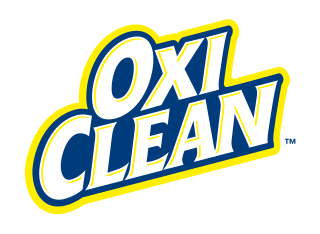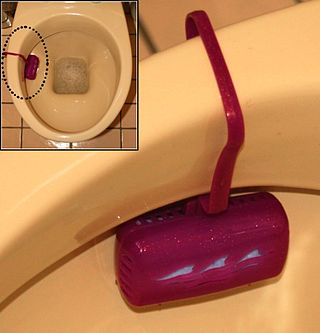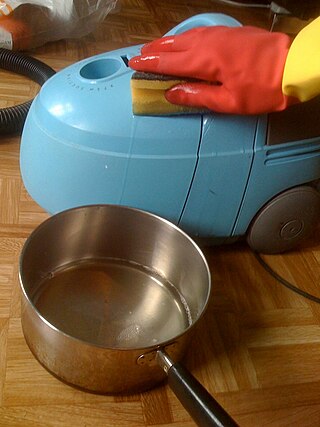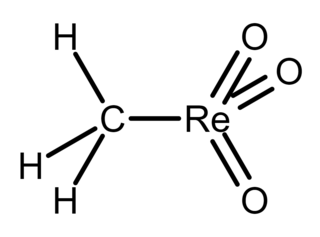Related Research Articles
A bactericide or bacteriocide, sometimes abbreviated Bcidal, is a substance which kills bacteria. Bactericides are disinfectants, antiseptics, or antibiotics. However, material surfaces can also have bactericidal properties based solely on their physical surface structure, as for example biomaterials like insect wings.

A carbonate is a salt of carbonic acid, H2CO3, characterized by the presence of the carbonate ion, a polyatomic ion with the formula CO2−3. The word "carbonate" may also refer to a carbonate ester, an organic compound containing the carbonate groupO=C(−O−)2.

Sodium percarbonate or sodium carbonate peroxide is a chemical substance with formula Na2H3CO6. It is an adduct of sodium carbonate and hydrogen peroxide whose formula is more properly written as 2 Na2CO3 · 3 H2O2. It is a colorless, crystalline, hygroscopic and water-soluble solid. It is sometimes abbreviated as SPC. It contains 32.5% by weight of hydrogen peroxide.

OxiClean is an American brand of household cleaners, including OxiClean Versatile Stain Remover, which is a laundry additive, spot stain remover, and household cleaner marketed by Church & Dwight. It was formerly owned by Orange Glo International from its introduction in 1997 until it was acquired in 2006.
Persil Power was a laundry detergent product developed and sold in the mid-1990s by Unilever.
Sodium perborate is chemical compound whose chemical formula may be written NaH2BO4, Na2H4B2O8, or, more properly, [Na+]2[B2O4(OH)4]2−. Its name is sometimes abbreviated as PBS.

Tetraacetylethylenediamine, commonly abbreviated as TAED, is an organic compound with the formula (CH3C(O))2NCH2CH2N(C(O)CH3)2. This white solid is commonly used as a bleach activator in laundry detergents and for paper pulp. It is produced by acetylation of ethylenediamine.
Peracetic acid (also known as peroxyacetic acid, or PAA) is an organic compound with the formula CH3CO3H. This peroxy acid is a colorless liquid with a characteristic acrid odor reminiscent of acetic acid. It can be highly corrosive.
Alkali salts or base salts are salts that are the product of incomplete neutralization of a strong base and a weak acid.
Oxyper is a Solvay coated and stabilised sodium carbonate peroxyhydrate which combines the properties of sodium carbonate and hydrogen peroxide. It is an odorless, crystalline, white powder used, when dissolved in water, in cleaning and bleaching applications and as a beer keg and line cleaner. It is a brand name of the Solvay S.A. Corporation, headquartered in Brussels.
Sodium nonanoyloxybenzenesulfonate (NOBS) is an important component of laundry detergents and bleaches. It is known as a bleach activator for active oxygen sources, allowing formulas containing hydrogen peroxide releasing chemicals to effect bleaching at lower temperatures.

A toilet rim block is a substance in the shape of a block that is used in flush toilets, which slowly dissolves in water. The blocks usually come in a small holder that is attached over the rim of a toilet and hangs down into the bowl, so as the toilet gets flushed, the water passes through the holder coming into contact with the block. With "liquid rims", however, liquid is held in a small bottle above—and connected to—the holder that slowly releases into the bottom of the holder, and so coming into contact with the water when the toilet is flushed.

Bleach is the generic name for any chemical product that is used industrially or domestically to remove colour from fabric or fiber or to disinfect after cleaning. It often refers specifically to a dilute solution of sodium hypochlorite, also called "liquid bleach".

Cleaning agents or hard-surface cleaners are substances used to remove dirt, including dust, stains, foul odors, and clutter on surfaces. Purposes of cleaning agents include health, beauty, removing offensive odors, and avoiding the spread of dirt and contaminants to oneself and others. Some cleaning agents can kill bacteria and clean at the same time. Others, called degreasers, contain organic solvents to help dissolve oils and fats.

Methylrhenium trioxide, also known as methyltrioxorhenium(VII), is an organometallic compound with the formula CH3−ReO3. It is a volatile, colourless solid that has been used as a catalyst in some laboratory experiments. In this compound, rhenium has a tetrahedral coordination geometry with one methyl and three oxo ligands. The oxidation state of rhenium is +7.

Pyridine-N-oxide is the heterocyclic compound with the formula C5H5NO. This colourless, hygroscopic solid is the product of the oxidation of pyridine. It was originally prepared using peroxyacids as the oxidising agent. The compound is used infrequently as an oxidizing reagent in organic synthesis.

In chemistry, peroxydicarbonate is a divalent anion with the chemical formula C
2O2−
6. It is one of the oxocarbon anions, which consist solely of carbon and oxygen. Its molecular structure can be viewed as two carbonate anions joined so as to form a peroxide bridge –O–O–.

In chemistry, peroxycarbonate or percarbonate is a divalent anion with formula CO2−
4. It is an oxocarbon anion that consists solely of carbon and oxygen. It would be the anion of a hypothetical peroxycarbonic acid HO–CO–O–OH. or the real hydroperoxyformic acid, HO-O-CO-OH.

Roof cleaning is the process of removing algae, mold, mildew, lichen and moss from roofs. Also cleaning oxidation on metal roofs. Cleaning can extend the duration of a roof's ability to function. Algae and other types of build-up often form on the north and west parts of roofs that are shaded or receive less sun, and can reduce a roof's life expectancy. The presence of soot, dirt, or biomass can affect how much sunlight is absorbed by a roof and thus the amount of heat a building absorbs.

Metal peroxides are metal-containing compounds with ionically- or covalently-bonded peroxide (O2−
2) groups. This large family of compounds can be divided into ionic and covalent peroxide. The first class mostly contains the peroxides of the alkali and alkaline earth metals whereas the covalent peroxides are represented by such compounds as hydrogen peroxide and peroxymonosulfuric acid (H2SO5). In contrast to the purely ionic character of alkali metal peroxides, peroxides of transition metals have a more covalent character.
References
- ↑ Saxena, P. B. (2007). Inorganic Polymers. Discovery Publishing House. ISBN 9788183562287.